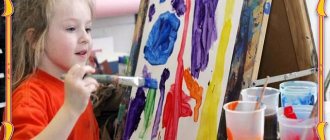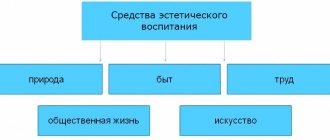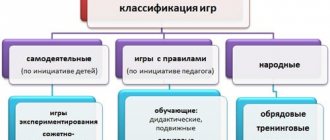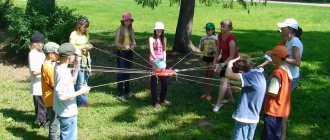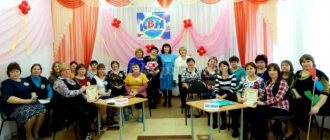The role of play activities in the development of preschool children and the problems of its organization in preschool educational institutions
Play activities have a great influence on the physical, moral, labor and aesthetic education of preschool children. This is due to the fact that play is the leading activity of a preschooler. It helps to activate the child’s vitality, satisfies his needs for movement, personal interests and social needs.
Despite the fact that play activity is an important need of the child and is of great importance in his development, modern preschool institutions are increasingly faced with the question of improving the organization of play activity. Some kindergartens, especially rural ones, do not have the opportunity to create an appropriate play environment. This is primarily due to problems with their financing. Also, one of the problems in organizing gaming activities in preschool educational institutions is the lack of attention to amateur games that influence the formation of children’s ideas about the world around them.
Are you an expert in this subject area? We invite you to become the author of the Directory Working Conditions
Quite often, when organizing play activities in preschool educational institutions, educators strive to subordinate the game to the tasks of raising, teaching or developing children. This only causes harm, as it leads to a decrease in motivation in children, which is the basis for the formation of the educational activity of every preschooler.
Another problem in organizing play activities in preschool educational institutions is that most young specialists (educators) lose sight of the fact that a child, especially one of primary preschool age, does not fully master play activities; he must be taught to play. In connection with this, sometimes the time allocated for play activities is used by educators to conduct training sessions, prepare for holidays, matinees, etc.
In order to eliminate these problems, it is first of all necessary that preschool teachers understand and realize the importance of gaming activities for the upbringing, training and development of preschool children. You should organize play activities purposefully, remember that play as one of the child’s specific activities is not homogeneous, and each of its types is aimed at developing one or another aspect of the child’s personality.
Finished works on a similar topic
Course work Organization of play activities in a preschool educational organization 420 ₽ Abstract Organization of play activities in a preschool educational organization 260 ₽ Test work Organization of play activities in a preschool educational organization 190 ₽
Receive completed work or specialist advice on your educational project Find out the cost
Conventionally, all games are divided into three main types:
- Creative games – organized at the child’s initiative.
- Didactic and outdoor games - organized on the initiative of an adult, have certain rules and conditions.
- Folk games are games created by the people.
MAGAZINE Preschooler.RF
Game as a form of organizing the life and activities of preschool children1. What does the statement mean that “game is a form of organizing children’s lives .
The main type of independent activity of a preschooler is play. Play is an activity in its own right for a preschooler, providing him with a sense of freedom, control over things, actions, relationships, allowing him to realize himself most fully “here and now” , achieve a state of emotional comfort, and become involved in a children's society built on the free communication of equals. Play is also of great importance for the development of a child. It develops the ability to imagine, voluntarily regulate actions and feelings, and acquire experience of interaction and mutual understanding. It is the combination of the subjective value of play for a child and its objective developmental value that makes play the most suitable form of organizing children’s lives. (No. 4 p. 19)
The understanding of play as a form of organizing the life and activities of children is based on the following provisions.
- The game is designed to solve general educational problems, among which the tasks of forming the moral and social qualities of the child are of primary importance.
- Play, especially in older preschool age, should be amateur in nature and increasingly develop in this direction, subject to proper pedagogical guidance.
- An important feature of play as a form of organizing children’s lives is its penetration into various types of activities: work and play, educational activities and play, everyday household activities associated with the implementation of the regime, and play. (No. 6 p. 7)
Occupying a certain place in the lives of adults, play has a special meaning for children. It is customary to call her “childhood companion . For preschool children, it constitutes the main content of life, acts as a leading activity, closely intertwined with work and learning. Many serious matters for a child take the form of play. All aspects of the personality are involved in it: the child speaks, moves, perceives, thinks; During the game, his imagination and memory actively work, emotional and volitional manifestations intensify. The game acts as an important means of education. (No. 2 p.93)
One of the provisions of the pedagogical theory of play is the recognition of play as a form of organizing the life and activities of preschool children. The first attempt to organize the lives of children in the form of games belonged to F. Froebel. He developed a system of games, mainly didactic and active, on the basis of which educational work was carried out in kindergarten. The entire time the child was in kindergarten was scheduled with different types of games. Having completed one game, the teacher involved the children in a new one.
In Russian pedagogy, the idea that the life of a kindergarten should be filled with a variety of games was persistently developed by N.K. Krupskaya. Noting the exceptional importance of games for preschool children N.K. Krupskaya wrote: “... play for them is study, play for them is work, play for them is a serious form of education. Play is a way for preschoolers to learn about their surroundings . Therefore, according to the deep conviction of N.K. Krupskaya, the teacher’s task is to help children organize games, to unite them in play.
The scientific basis for play as a form of organizing the life and activities of children in kindergarten is contained in the works of A.P. Usova. According to A.P. Usova, the teacher must be at the center of the child’s life, understand what is happening, delve into the interests of the children at play, and skillfully guide them.
However, when directing the game towards solving educational problems, one should always remember that it is a kind of independent activity of a preschooler. In play, the child has the opportunity to demonstrate independence to a greater extent than in any other activity: he chooses the plots of the game, toys and objects, partners, etc. It is in play that the social life of children is most fully activated. The game allows children to independently use certain forms of communication already in the first years of life.
During the game, two types of relationships develop between children:
- relationships that are determined by the content of the game (students obey the teacher, children obey their parents, the engineer directs the workers), the rules of the game (at a signal, the heron goes out to catch frogs, and they hide, freeze, then the heron stands motionless in the swamp, and the frogs jump and frolic; c You can't argue with a heron that caught a frog)
- real relationships that manifest themselves regarding the game (conspiracy to play, distribution of roles, way out of the conflict that has arisen between the players, establishment of rules).
Under favorable conditions, children master social behavior skills. A.P. Usova rightly noted that the ability to establish relationships with peers in a game is the first school of social behavior. Social feelings and habits are formed on the basis of relationships; the ability to act collaboratively and purposefully develops; comes an understanding of common interests; the foundations of self-esteem and mutual assessment are formed. The high importance of play activity lies in the fact that it has the greatest potential for the formation of a children's society. (No. 3 pp. 272-275)
Subject to the purposeful development of gaming skills and control over children’s independent play, play becomes a form of organizing children’s life.
2. Characteristics of methods for constructing a story game and features of the manual.
ON THE. Korotkova, N.Ya. Mikhailenko propose to consider the management of a role-playing game as a process of gradually transferring to preschoolers increasingly complex ways of constructing a game. The transfer of methods is carried out in a joint game between an adult and children.
There are the following ways to build a game:
- a sequence of object-game actions with the help of which children imitate a real object action using appropriate objects and toys (early and junior preschool age)
- role-playing behavior, with the help of which the child imitates the actions characteristic of the character, using speech and objects (middle preschool age)
- plotting, through which the child builds individual elements of the plot into a holistic event (senior preschool age).
Each stage is valuable in itself and is a significant means of its development. Children master the first method of constructing a game (object-based play actions) in joint activities with adults. The other two methods (role behavior, plotting) require the participation of an adult. (No. 3 p. 308)
Mikhailenko N.Ya. and Korotkova N.A. found that in the age range of 1.5-3 years, a child can carry out conditioned actions with toys and substitute objects, building them into a simple semantic chain, entering into short-term interaction with a peer; at 3-5 years old – can accept and consistently change play roles, implement them through actions with objects and role-playing speech, enter into role-playing interaction with a peer partner; at 5-7 years old - unfold various sequences of events in the game, combining them according to one’s own plan and the plans of two or three peer partners, implement plot events through role-playing interactions and objective actions. (No. 7 pp. 11-12)
The management of role-playing games is carried out in two directions:
- formation of the game as an activity
- the use of games as a means of educating a child and forming a children's team.
The formation of a game as an activity assumes that the teacher influences the expansion of the themes of role-playing games, deepens their content, and promotes children’s mastery of role-playing behavior.
Techniques for managing a game in order to form it as an activity can be divided into traditional ones (developed by R.I. Zhukovskaya, D.V. Mendzheritskaya) and new ones, studied in recent years (N.A. Korotkova, N.Ya. Mikhailenko). (No. 3 p. 303)
In the game management techniques developed by R.I. Zhukovskaya. and Mendzheritskaya D.V. There are two groups of techniques:
- methods of indirect influence, i.e. management of the game is carried out by enriching children's knowledge about the surrounding life, updating game materials, etc., i.e. without direct intervention in the game. This preserves children's independence during play. One of the methods of indirectly influencing children’s games is to introduce toys and create a play environment before the game begins. This technique is used to arouse interest in a new theme of the game or enrich the content of an existing one.
- direct leadership techniques, i.e. role-playing participation in the game, participation in the collusion of children, explanation, help, advice during the game, suggesting a new topic for the game, etc. Direct guidance techniques make it possible to purposefully influence the content of the game, the relationships of children in the game, and the behavior of the players. The main condition for their use is the preservation and development of children’s independence in play. (No. 2 p. 120-122)
The rule should be taken into account: as children grow in activity and independence, it is advisable to use mainly indirect methods of influence (reminders of children’s past games, what they saw; leading questions, timely changes in the play environment, organization of visual, labor, constructive activities that can encourage to the game). (No. 3 p. 305)
3. Classification of games, criteria and authors.
Children's games are a heterogeneous phenomenon. Games are varied - in their content, the degree of independence of children, forms of organization, and game material. In pedagogy, repeated attempts have been made to study and describe each type of game, taking into account its functions in the development of children, and to give a classification of games.
Due to the diversity of children's games, it turns out to be difficult to determine the initial basis for their classification. Each game theory proposes criteria that meet a given concept. Thus, F. Frebel, being the first among teachers to put forward the position of play as a special means of education, based his classification on the principle of the differentiated influence of games on
- development of the mind (mental games)
- external senses (sensory games)
- movements (motor games).
Classification of games by the German psychologist K. Gross:
- “Games of ordinary functions” - games that are active, mental, sensory, and develop the will;
- “Games of special functions” - games that are exercises for the purpose of improving instincts (family games, hunting games, courtship, etc.)
In domestic preschool pedagogy, a classification of children's games has developed, based on the degree of independence and creativity of children in the game. Initially, P.F. approached the classification of children's games according to this principle. Lesgaft, later his idea was developed in the works of N.K. Krupskaya.
P.F. Lesgaft divided children's games into two groups:
- imitative (imitative)
- active (games with rules).
P.F. Lesgaft believed that preschool age is a period of imitation of new impressions and their awareness through mental work. In the first 6-7 years of life, a child’s desire to reflect and comprehend impressions about the life around him is satisfied in games that are imitative in content and independent in organization, without unnecessary regulation on the part of adults. During school years, on the contrary, children are more willing to play specially created games in which activities are regulated both in content and form.
In the works of N.K. Krupskaya’s children’s games are divided into two groups according to the same principle as P.F. Lesgaft, but are called a little differently:
- creative games (independent) - invented by the children themselves
- games with rules invented by adults.
Like any classification, this classification of children's games is conditional.
Classification of games Mendzheritskaya D.V., Zhukovskaya R.I.
- creative games: role-playing games, dramatization games, games with building materials
- games with rules: didactic games, outdoor games.
Based on the classification of children's games developed by S.L. Novoselova, lies the idea of whose initiative games arise (a child or an adult).
There are three classes of games:
1. games arising at the initiative of the child (children):
- experimentation game
- independent games: independent plot games (plot-display, plot-role-playing, director's, theatrical)
2. games that arise on the initiative of an adult who introduces them for educational and educational purposes:
- educational games (didactic, plot-didactic, active)
- leisure games (fun games, entertainment games, intellectual games, festive carnival games, theatrical performance games)
3. games coming from the historically established traditions of the ethnic group (folk), which can arise on the initiative of both an adult and older children:
- traditional or folk (historically they form the basis of many educational and leisure games). (No. 3 p.278-279)
4. Types of construction games and researchers.
Construction games are a type of creative game. In them, children reflect their knowledge and impressions about the surrounding objective world, do various things independently, erect buildings and structures, but in a very generalized and schematized form.
In construction games, some objects are replaced by others: buildings are erected from specially created building materials and construction materials, or from natural materials (sand, snow). All this gives reason to consider such activity as one of the types of creative play. (No. 2 p. 127)
In a preschool institution, children are taught to design using play building materials, paper, soft cardboard, and natural materials. The type of material determines the type of design.
There are three types of design:
- construction from building materials.
- design from paper and additional materials.
- construction from natural materials. (No. 5 p. 8-9)
Researchers of construction-constructive games, their features and significance are Lishtvan Z.V., Nechaeva V.G.
4. Types of construction and constructive games and researchers.
Construction and constructive games are a type of creative game. Children reflect knowledge and impressions about the objective world, do various things independently, but in a generalized, schematized form.
Types of design.
1) By designing according to a model, children develop various skills, master general methods of action, master the sequence of operations, and learn the constructive capabilities of building materials.
2) Design on a given topic is a creative embodiment of the task, but the limits of its solution are limited by the topic.
- For kids, the theme is building furniture and equipment for the site
- In the middle group, the topic is vehicle design
- In the older group - topics such as military or construction equipment; people's homes, museums, theaters of our city, etc.
- In the preparatory group, it is advisable to carry out thematic construction using constructors of various types.
3) Design according to one’s own plan is a complex type of design; the child himself decides, sets a goal, plans, selects materials, and implements the plan.
4) Design according to conditions contains great developmental opportunities. Children should already be able to build this or that object, a building. Certain parameters are set, and the child will decide for himself. Research on this species was carried out by N.N. Poddyakov, L.A. Paramonova – mental activity influences the formation of generalized ideas.
5) “Construction based on models” - developed by A.R. Luria. The child is offered a model of the building with hidden outlines of the constituent elements of the structure. The child first analyzes the model and then selects the shapes needed to recreate it. The child begins to mentally combine.
The content of games with building materials is creation, reproduction of the surrounding reality using various materials.
Types of building material:
- specially created (floor, tabletop building material, sets such as “Young Architect” , “Ancient Castle” , construction sets).
- natural (sand, snow, clay, stones).
- utility room (boards, boxes, boxes, etc.).
“...Children do not like toys that are stationary, finished, well-finished, which they cannot change according to their imagination... the best toy for a child is one that he can make change in the most varied ways...” . K. D. Ushinsky.
In the history of pedagogy, games with building materials have been described quite a long time ago and are represented in many systems (F. Froebel’s system, “Waldorf pedagogy” , K.K. Schleger’s system, etc.).
Studied in domestic preschool pedagogy (V.G. Nechaeva, Z.V. Lishtvan, A.N. Davidchuk, L.A. Paramonova).
In the studies of N.N. Poddyakova, L.A. Paramonova has proven that games contribute to the development of thinking and spatial imagination.
Literature:
- Preschool pedagogy / Ed. V. I. Loginova, P. G. Samorurova. - M.: Education, 1983. - 288 p.
- Kozlova S. A., Kulikova T. A. Preschool pedagogy - M.: "Academy" , 1998. - 432 p.
- Z.V. Lishtvan “Games and activities with building materials in kindergarten” , M., 1971.
- The place of didactic games in the pedagogical process.
In preschool pedagogy, many specialists have been studying and conducting didactic games (Usova A.P., Sorokina A.I., Udaltsova E.I., Avanesova V.N., etc.). Moreover, some consider the game only a means of consolidating the knowledge acquired in the classroom, while others rightly object to such a narrow understanding of the meaning of the game, consider it one of the forms of learning, an important means of educational work. This view of the didactic game is determined by the educational objectives that schools and kindergartens face: not only to give children a certain amount of knowledge, but also to teach them to master this knowledge, equip them with mental work skills, and develop activity and independent thinking. (No. 6 p. 115-116)
A didactic game as a gaming approach is considered in two types: game-activities and didactic, or autodidactic, games. With the help of games-activities, the teacher not only conveys certain knowledge, forms ideas, but also teaches children to play. The didactic game is used in teaching children mathematics, their native language, familiarization with nature and the surrounding world, and in the development of sensory culture. A didactic game as a form of teaching children contains two principles: educational (cognitive) and gaming (entertaining). The teacher is both a teacher and a participant in the game. He teaches and plays, and children, while playing, learn. The didactic game as an independent gaming activity is based on the awareness of this process. Independent play activity is carried out only if children show interest in the game, its rules and actions, if these rules have been learned by them. Children can play educational games on their own both in and outside of class. Didactic games develop children’s sensory abilities, develop children’s speech and thinking, cultivate children’s moral feelings and attitudes, develop children’s respect for working people, arouse interest in the work of adults, and a desire to work themselves. The game creates a positive emotional uplift and makes you feel good. Many didactic games develop cultural and hygienic skills. In play, children clearly express their social feelings and strive to do everything together.
So, a didactic game is a multifaceted, complex pedagogical phenomenon: it is a gaming method of teaching preschool children, a form of education, an independent gaming activity, and a means of comprehensive education of a child’s personality. (No. 1 p. 4-10)
List of used literature:
- Bondarenko A.K. Didactic games in kindergarten: Book. for a kindergarten teacher garden — 2nd ed., revised. – M.: Education, 1991
- Preschool pedagogy. Textbook manual for pedagogical students. Inst. In 2 hours. Part 2/ Ed. IN AND. Loginova, P.G. Samorukova. – 2nd ed., rev. and additional – M.: Education, 1988.
- Kozlova S.A., Kulikova T.A. Preschool pedagogy: textbook. aid for students avg. ped. textbook establishments. – M.: Publishing House, 1998.
- Preschool education concept. // DV No. 5 1989, p. 10.
- Lishtvan Z.V. Construction: A manual for kindergarten teachers. – M.: Education, 1981.
- Mendzheritskaya D.V. To the teacher about children's play: A manual for teachers of children. garden / Ed. T.A. Markova. – M.: Education, 1982.
- Mikhailenko N.Ya., Korotkova N.A. Organizing a story-based game in kindergarten: a guide for teachers. – 3rd ed., rev. – M.: LINKA-PRESS, 2009.
| Next > |
Organization of creative play activities. Folk games
Definition 2
Creative games are games in which children independently determine the goal of the game, its rules and content.
Basically, creative play activities reflect the surrounding activities of people and the relationships between people. Most creative games are role-playing games in which children play various roles, “trying on” social roles (professions, social status, etc.).
In addition to role-playing games, creative play activities include games with labor elements, artistic and creative activities, theatrical activities and construction games.
Thus, during creative play activities, children have the opportunity to gain certain social experience, satisfy their own interests and needs for movement.
Definition 3
Folk games are games that originate from ancient times, built taking into account ethnic characteristics.
Folk games include round dances, games with folk toys, fun, etc.
The folk game is an integral part of the life of a preschooler. This is due to the fact that it is folk games, more than any other games, that are aimed at developing universal human values in children. In addition, folk games introduce children to the history and traditions of the people and show the characteristics of the ethnic group.
Within the preschool educational institution, the organization of folk games is carried out as an independent activity, as well as as part of various festive events (Maslenitsa, farewell to winter, Christmas, etc.).
Psychological and pedagogical characteristics of the game
The definitions of play discussed earlier and its significance in the personal development of preschoolers allow us to highlight the following psychological features of the game:
- play is a form of active reflection by a child of the people around him.
- A distinctive feature of the game is also the method that the child uses in this activity. Play is carried out through complex actions, rather than individual movements (as, for example, when working, writing, drawing).
- the game, like any other human activity, has a social nature, so it changes with changes in the historical conditions of people's lives.
- play is a form of creative reflection of reality by a child. While playing, children bring many of their own inventions, fantasies, and combinations into their games.
- play is an operation of cognition, a means of clarifying and enriching it, a way of exercising and developing the child’s cognitive and moral abilities and strengths.
- in its expanded form, play is a collective activity. All participants in the game are in a cooperative relationship.
- Thanks to the diversity in children's development, the game itself also changes and develops. With systematic guidance from the teacher, the game can change:
- From the beginning to the end;
- from the first match to subsequent matches of the same group of children;
- The most significant changes in play occur as children develop from younger to older ages.
- play as an activity is aimed at ensuring that children learn about the world around them through active participation in the work and everyday life of people
The means of the game are:
- Knowledge about people, their actions, relationships, expressed in linguistic images, in the experience and actions of the child;
- courses of action with certain objects in certain circumstances;
- Moral assessments and feelings that are manifested in judgments about the good and bad, useful and harmful actions of people.
